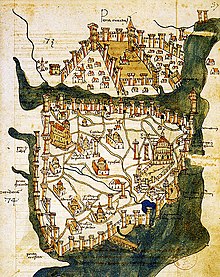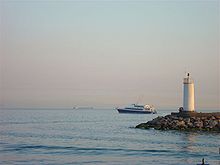Account Scalion
The Kontoskalion ( Greek Κοντοσκάλιον ) - also Julian Harbor , New Harbor or Sophia harbor and in the Ottoman period Kadırga Limanı was a - ( "Galley Harbor") Byzantine port of Constantinople Opel , which built in the 4th century until the Ottoman period entertain has been.
location
The port was on the coast of the Propontis ( Sea of Marmara ) below the Hippodrome and the Great Palace . The former port area is located in what is now Kadırga Limanı and Kumkapı in the Istanbul district of Fatih .
history
Byzantine period

Even during the reign of Constantine the Great , the site of the later port was used as a landing stage. In 362, during a short stay on the way to a campaign against the Persians in the city , the Roman emperor Julian built a port called portus novus or portus Iulianus . At the same time he erected the crescent-shaped sigma or porticus semirotunda in front of it . A statue commemorated the builder until it fell victim to an earthquake in 535 and was replaced by a cross by Justinian I.
The decision to build was made in spite of the pending problems: A commercial port was an advantage here that should not be underestimated. However, the landing stages on the Propontis Coast were only slightly protected from the strong southwest wind from Lodo . The strong wind brought a lot of sand into the harbor basin and made frequent and expensive dredging necessary. In addition, heavy rains caused erosion in the surrounding mountains and the sediments were deposited in the harbor basin. The first traditional excavation with bucket wheels took place in 509.
On the other hand, however, the construction of a port on the southern coast of Constantinople was necessary to effectively supply the southern and western urban regions. It was not until the 5th century that another port was created on the coast of Constantinople with the Theodosius port. Between this and the Julianus port, two mighty granaries for grain deliveries from Egypt, and later also from Thrace , Macedonia and Asia Minor , were built. The area around the port developed into an upscale residential area.

In the first descriptions from the 6th century, the port was described as a port basin surrounded by a wall with an ammunition depot. The first maps of the city confirm these descriptions with an arsenal west of the Sokollu Mehmed Pasha Mosque near the old sea wall of Kumkapı, while the harbor basin was protected by a mole from the sea wall.
One of the biggest problems in the region was the repeated severe fires. A first serious fire broke out at the end of the 4th century and destroyed parts of the southern part of the city. In the 6th century, Emperor Anastasius I emptied the harbor basin with hydraulic machines, built a pier and had the sand sediment dredged. Later, possibly under Justinian I , part of the trade for imported goods from the Neorion port on the Golden Horn , the city's oldest port, was diverted to the new port and the market for these goods was also relocated here. Some sources consider a move of the market in the 7th or 8th century more likely, when the Neorion harbor in the Golden Horn was expanded to become the base of the navy.
After it was destroyed in another fire in 561, Justin II had the port dredged and enlarged again around 575: The work was supervised by the praepositus Narses and the protovestiarios Troilos. Four statues were erected in front of the large harbor, which was now called "Sophienhafen", depicting Emperor Justin, his wife Sophia, their daughter Arabia and Narses.
From the end of the 6th century, the port was also used for military purposes and became the home port of the Byzantine Navy. Emperor Philippikos Bardanes had two statues of the Kontoskalion removed because he considered their prophetic inscriptions to be unfavorable. During his reign, Emperor Theophilos maintained an arsenal with a shipyard and ammunition and weapons stores near the port and the porta Leonis (Ottoman Çatladı Kapı ) .
In the following time the port was mentioned repeatedly in historical sources. Around the year 867, the ship on which Saint Eustratios sailed from Bithynia to Constantinople is said to have sunk in the Sophienhafen; the saint and the crew had left it just in time. And Leon of Synada reported in 996 of an embarkation for Rome. The ship broke on departure and almost capsized. A military function of the Sophienhafen between 700 and 1200 cannot be proven. If there was an arsenal in the Middle Byzantine period, then it can be assumed that it was in the Golden Horn, where most of the navy was apparently at anchor. As early as 715, the Neorion served as a naval base and shipyard, but other areas of the arm of the sea may have been used for military purposes later.
Between the 9th and 11th centuries, the Patria Konstantinupoleos also referred to the port as the Kontoskalion . This also remained the modern Greek name for the district to the west of the port, whose Turkish name is Kumkapı . After the end of the Latin Empire , the name appeared in several sources as an account and created confusion among scientists. According to Patria this name was a patronymic that a Agallianos Kontoskeles reminded a Byzantine leader of a Turma , nicknamed Kontoskeles was due to its short legs. But the Byzantinist Albrecht Berger sees this as a misinterpretation of the Patria authors: “Account Scalion” means a short step or a small landing stage. Some authors, such as Raymond Janin, suspect that the name Kontoskelion ( Middle Greek πρὸς τὸ Βλάγκα Κοντοσκέλιον pros to Vlanka Kontoskelion ) could indicate another port around 150 meters west of the Sophienhafen, but the interpretation was discarded as the Kontoskalion harbor was rejected until the 15th Century was the only military port on the Marmara Sea.
In the 14th and 15th centuries, the port still had a number of important military functions. The shipyard produced warships and enabled a Byzantine navy to be rebuilt, and the port was the location of the navy. The use of the Kontoskalion as a military port is mentioned by the Russian pilgrim Stephan of Novgorod, who stayed in Constantinople around 1350. He described that the port could hold up to 300 dromons , but could not sail out in bad winds.
During the Palaiologoi dynasty protected Emperor Michael VIII. The harbor basin with a stone wall and a chain. His successor Andronikos II. Palaiologos deepened the port and protected the entrance with iron gates. The port was mentioned in an enkomium of Emperor John VIII in 1427. The document tells of repairs to the port ordered by John VIII and another dredging. Paid workers (including priests and monks) and no public servants were employed here. After that 300 galleys were able to dock in the harbor. In some versions of the map of the Florentine traveler Cristoforo Buondelmonti , who visited Constantinople in 1421, the port basin is seen flanked by an arsenal, and reports by the Spanish traveler Pero Tafur from 1437 suggest that the port was at that time was still in use. This remained so until the conquest of Constantinople by the Ottomans in 1453.
Ottoman time
After the fall of the city, Sultan Mehmet II had the port fortified with several towers in 1462. The port was now called Kadırga Limanı . In 1515 work began on building a new arsenal on the Golden Horn, the Tersâne-i Âmire , which was well protected there from the south- westerly storms and provided enough space for the enormously growing Ottoman fleet . This started the decline of the old port. In the 16th century, the French traveler and writer Pierre Gilles reported that around 1540 the women of the neighboring neighborhoods were washing their laundry in the harbor basin. Nevertheless, the port was shown as an active port on some maps from the 18th century. The end of Kadırga Limanı began with the construction of the Nuruosmaniye Mosque in 1748, as the excavation was partly poured into the old harbor basin.
literature
- Raymond Janin : Constantinople Byzantine. Développement urbaine et répertoire topographique. Institut Français d'Etudes Byzantines, Paris 1964.
- Wolfgang Müller-Wiener : Image lexicon on the topography of Istanbul: Byzantion, Konstantinupolis, Istanbul up to the beginning of the 17th century. Wasmuth, Tübingen 1977, ISBN 978-3-8030-1022-3 , pp. 62-63.
- Wolfgang Müller-Wiener: The ports of Byzantion, Konstantinupolis, Istanbul . Wasmuth, Tübingen 1994, ISBN 380301042X .
- Dominik Heher: Julianoshafen - Sophienhafen - Kontoskalion. In: Falko Daim (ed.): The Byzantine ports of Constantinople. Verlag des Römisch-Germanisches Zentralmuseums, Mainz 2016, ISBN 978-3-88467-275-4 , pp. 51-66 ( digitized version ).
Individual evidence
- ↑ a b c d e f g h i j k Müller-Wiener (1977), p. 62.
- ↑ a b c Janin (1964), p. 231.
- ↑ a b c d e f g h i j Dominik Heher (2016)
- ↑ a b Janin (1964), p. 225.
- ↑ a b c d e f g h i Müller-Wiener (1977), p. 63.
- ↑ Janin (1964), p. 28.
- ^ Albrecht Berger: Investigations on the Patria Konstantinupoleos. Habelt, Bonn 1988, ISBN 3774923574 , p. 483 f. ( Digitized version ).
- ↑ a b c d Janin (1964), p. 232.
- ↑ a b Janin (1964), p. 230.
- ↑ a b Janin (1964), p. 233.
Coordinates: 41 ° 0 ′ 3.6 ″ N , 28 ° 58 ′ 15.6 ″ E

